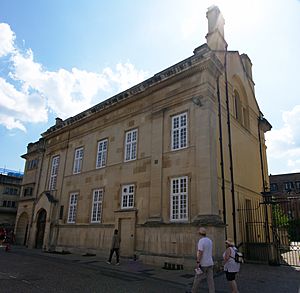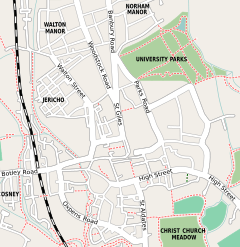New Inn Hall, Oxford facts for kids
Quick facts for kids New Inn Hall |
|
|---|---|

Hannington Hall in St Peter's College, Oxford, the surviving part of New Inn Hall's Cramer Building.
|
|
| University | University of Oxford |
| Location | New Inn Hall Street |
| Coordinates | 51°45′08″N 1°15′37″W / 51.7522°N 1.2603°W |
| Latin name | Aula Novi Hospitii |
| Established | c. 1360 |
| Closed | 1887 (incorporated into Balliol College) |
| Principal | see below |
| Map | |
New Inn Hall was one of the oldest and most important medieval halls at the famous University of Oxford. Think of these halls as early student hostels or small colleges. New Inn Hall was located on New Inn Hall Street in Oxford, England.
Contents
A Look Back: New Inn Hall's Story
The Very First Building: Trilleck's Inn
The story of New Inn Hall began with an even older building called Trilleck's Inn. This was a medieval hall for students, founded around 1360 by Bishop John Trilleck. After he passed away, the building was given to William of Wykeham, who was also a bishop. Later, in 1392, it became part of New College.
Becoming New Inn Hall
Around 1400 to 1420, students from a group called the Cistercians used the hall. Then, before 1476, the building was completely rebuilt and given a new name: the New Inn. This is how it became known as New Inn Hall.
As these inns grew into places where students learned and studied, New Inn Hall became especially known for its experts in law. Important people like Alberico Gentili, a top law professor, and Sir Daniel Donne, who was the first Member of Parliament (MP) for Oxford University, studied or taught here. Another famous law professor, Dr John Budden, was also connected to New Inn Hall.
During the First English Civil War, which was a big conflict in England, the university's valuable silver and gold items (called "college plate") were taken to New Inn Hall. They were melted down to make special coins known as "Oxford Crowns" to help fund the King's side in the war.
In 1833, John Cramer, who was the head of New Inn Hall at the time, built a new part called the Cramer Building. This was a hostel for students.
Joining Balliol College
In 1881, a new rule was made that New Inn Hall would join Balliol College. This merger happened in 1887. Balliol College took over New Inn Hall's student records from 1831 to 1887. They also received New Inn Hall's library, which had many law books from the 1700s. After the merger, the New Inn Hall buildings were used to house students who were training for the Indian Civil Service.
Becoming St Peter's College
Eventually, Balliol College no longer needed the New Inn Hall site, so it was put up for sale. In 1894, the Cramer Building was bought by Francis James Chavasse and W. Talbot Rice. They turned it into a missionary center and named it Hannington Hall.
Later, in 1929, Hannington Hall became part of a brand new college called St Peter's Hall. Today, it's known as St Peter's College. Francis Chavasse, who bought the building, was also the founder of this new college.
The rest of the New Inn Hall site was bought by the city council. The old buildings were taken down to make space for a new school called the Central Girls' School. Later, St Peter's College bought this school site as well.
Leaders of New Inn Hall: Principals
Many different people served as the head of New Inn Hall over the centuries. They were called "Principals." Here is a list of the people who held this important role:
- 1438 William Freman
- 1444 Jeffrey (Griffith) Eberjow
- 1445 William Witney
- 1457 Philip Bergavenny (Abergeyney)
- 1461 Walter Pavy
- 1462 Edward Hanington (Hanyngton)
- 1468 Laurence Cocks
- 1469 Dionysius Hogan
- 1469 Philip Welsh
- 1484 John Lychfeild
- 1490 Richard Carpenter
- 1497 – Powtrell
- 1499 Richard (Robert) Bond
- 1500 Christopher Wardall (Warthiall)
- 1503 John Lacy
- 1504 Richard Salter
- 1510 William Balborow
- 1514 John Worthiall
- 1520 John Payne
- 1528 Roger Carew
- 1529 Thomas Barrett
- 1529 Henry Wright
- 1530 William Roberts
- 1534 Rowland Meyrick
- 1534 William Roberts
- 1542 Richard Richardson
- 1545 David Lewis
- 1548 John Gibbon
- 1550 William Aubrey
- 1550 Hugh Powell
- 1550 Thomas Powell
- 1561 John Griffith
- 1564 Robert Lougher
- 1570 Richard Bray
- 1571 Felix Lewes
- 1575 Robert Lougher
- 1580 Daniel Donne
- 1581 Edmund (Edward) Price
- 1584 John Estmond
- 1585 Francis Bevans
- 1586 Robert Crane
- 1599 John Ferrar
- 1609 John John Budden
- 1618 Charles Twysden
- 1621 Robert Lodington
- 1626 Christopher Rogers (deprived)
- 1643 Christopher Prior
- 1646 Christopher Rogers
- 1662 John Lamphire
- 1663 William Stone
- 1684 Thomas Bayley
- 1709 John Brabourne
- 1726 John Wigan
- 1732 D'Bloissiers Tovey
- 1745 William Walker
- 1761 William Blackstone
- 1766 Robert Chambers
- 1803 Dr James Blackstone
- 1831–1847 John Anthony Cramer
- 1847–1866 Henry Wellesley
- 1866–1887 Henry Hubert Cornish


